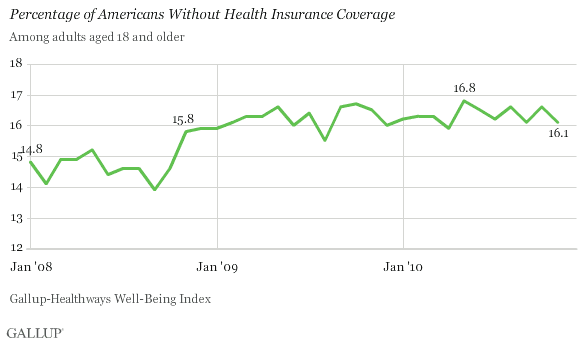WASHINGTON, D.C. -- A new low of 44.8% of American adults report getting their health insurance through an employer in November, down from 50% in January 2008, when Gallup began tracking it. The percentage of Americans with government-based healthcare remains elevated, with the 26% who report having it last month similar to the high of 26.3% found in September.

Half of Americans reported having employer-based health coverage in January and February 2008. The figure remained near the 49% mark throughout much of the rest of that year, before dropping to 48% in November 2008, as the financial crisis and unemployment worsened. Over the same time period, Gallup has tracked an increase in the percentage of Americans with government healthcare -- Medicare, Medicaid, or military/veterans' benefits.
Gallup asks Americans about their healthcare coverage daily as part of the Gallup-Healthways Well-Being Index. The monthly data for November are based on interviews with 27,218 Americans.
Nearly one in six (16.1%) American adults report that they did not have health insurance in November, a figure that is down slightly from a high of 16.8% in May of this year.

The number of uninsured increased significantly in the fall of 2008 and rose above 16% for the first time in February 2009. Since that time, approximately one in six Americans continue to report that they are uninsured.
Bottom Line
Even as the Obama administration works to implement various aspects of the new healthcare law, many lawmakers in Congress and in numerous U.S. states are actively trying to reverse or change it. A U.S. District Court judge in Virginia on Monday declared a key part of the Affordable Care Act unconstitutional. The ruling against the provision requiring all Americans to buy health insurance starting in 2014 is the first to strike down any part of the law and has created additional uncertainty about its fate. The final decision on the matter could significantly affect whether the elevated number of the uninsured in America decreases over time, one of the primary goals of the legislation.
Although up significantly from 2008, the average percentage of uninsured Americans so far in 2010 is essentially on par with 2009. The number of Americans who say they have employer-based coverage, however, is steadily declining this year compared with last, while the number of those with government healthcare is increasing. The increase in those with government healthcare likely stems from an increasing number of baby boomers becoming eligible for Medicare, as well as a continuing high unemployment rate, which is moving more Americans off employer-based plans and increasing the percentage relying on Medicaid.
Gallup and Healthways will continue to monitor health insurance coverage in the United States and regularly report updates on Gallup.com.
About the Gallup-Healthways Well-Being Index
The Gallup-Healthways Well-Being Index tracks U.S. well-being and provides best-in-class solutions for a healthier world. To learn more, please visit well-beingindex.com.
Survey Methods
Results are based on telephone interviews conducted as part of the Gallup-Healthways Well-Being Index survey Nov. 1-30, 2010, with a random sample of 27,218 adults, aged 18 and older, living in all 50 U.S. states and the District of Columbia, selected using random-digit-dial sampling.
For results based on the total sample of national adults, one can say with 95% confidence that the maximum margin of sampling error is ±1 percentage point.
Interviews are conducted with respondents on landline telephones and cellular phones, with interviews conducted in Spanish for respondents who are primarily Spanish-speaking. Each daily sample includes a minimum quota of 150 cell phone respondents and 850 landline respondents, with additional minimum quotas among landline respondents for gender within region. Landline respondents are chosen at random within each household on the basis of which member had the most recent birthday.
Samples are weighted by gender, age, race, Hispanic ethnicity, education, region, adults in the household, cell phone-only status, cell phone-mostly status, and phone lines. Demographic weighting targets are based on the March 2009 Current Population Survey figures for the aged 18 and older non-institutionalized population living in U.S. telephone households. All reported margins of sampling error include the computed design effects for weighting and sample design.
In addition to sampling error, question wording and practical difficulties in conducting surveys can introduce error or bias into the findings of public opinion polls.
For more details on Gallup's polling methodology, visit https://www.gallup.com/.
